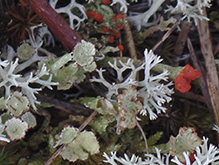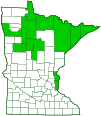Felt Horn Lichen
(Cladonia phyllophora)
Conservation • Description • Ecology • Distribution • Taxonomy
Conservation Status |
|
|||||||
| IUCN Red List | not listed |
|||||||
| NatureServe | NNR - Unranked |
|||||||
| Minnesota | not listed |
|||||||
Description |
||
Felt Horn Lichen is a widespread, common, shrubby (fruticose) lichen. It occurs around the globe in the northern latitudes. In Minnesota it is common in the northern third of the state, rare to absent elsewhere. It grows on the ground in full sun or partial shade. Felt Horn Lichen produces two types of vegetative growth (thallus). The primary thallus is a leaf-like scale (squamule) that lies on the soil. The squamules are 1 ⁄16″ to ⅝″ (2 to 15 mm) long and 1 ⁄16″ to ⅛″ (2 to 4 mm) wide. They may be scattered, clustered, or dense and overlapping. The margins have many ascending lobes. The upper surface is lime green, olive green, or grayish-green, and smooth, not covered with granules (soredia). The lower surface is white. The squamules often disappear as the secondary thallus grows. The secondary thallus is a vertical, usually unbranched, 5 ⁄16″ to 3⅛″ (8 to 80 mm) tall, 1 ⁄32″ to ⅛″ (1 to 4 mm) thick stalk (podetium) that rises from the center of a squamule. It is lime green, olive green, or grayish-green. It may be all one color but is often mottled or spotted. The layer of protective tissue (cortex) is split longitudinally. Many of the stalks broaden gradually at the tip into a cup. The cup is weakly or strongly convex and is wavy or lobed on the margins. It is shaped like a trumpet (horn) and has a puffy, soft (felty) surface, features that gives this lichen its common name. Abundant brown, 1 ⁄32″ to 1 ⁄16″ (1 to 2 mm) in diameter reproductive structures (apothecia) appear on the margins of the cups and at the tips of branches that do not produce cups. |
||
Similar Species |
||
Trumpet Lichen (Cladonia fimbriata) is smaller. The squamules are no more than ¼″ (6 mm) long, and they are persistent, remaining as the secondary thallus matures. The podetia are no more than 13⁄16″ (30 mm) tall. The cups are deeply convex. Apothecia are uncommon. |
||
Ecology |
||
Substrate |
||
Ground |
||
Growth Form |
||
Fruticose |
||
Habitat |
||
|
||
Hosts |
||
|
||
Distribution |
||||
|
Sources |
|||
| 8/24/2019 | ||||
Occurrence |
||||
Widespread and common |
||||
Taxonomy |
|||
| Kingdom | Fungi (fungi including lichens) | ||
| Subkingdom | Dikarya | ||
| Phylum | Ascomycota (Sac Fungi) | ||
| Subphylum | Pezizomycotina (Sac Fungi and Lichens) | ||
| Class | Lecanoromycetes (Common Lichens) | ||
| Subclass | Lecanoromycetidae (Shield Lichens, Sunburst Lichens, Rosette Lichens, and Allies) | ||
Order |
Lecanorales (Shield Lichens, Rim Lichens, and Allies) | ||
Family |
Cladoniaceae (Spindles and Structured Lichens) | ||
Genus |
Cladonia (Pixie Cup and Reindeer Lichens) | ||
| Mycobiont | Cladonia phyllophora | ||
| Photobiont | |||
Synonyms |
|||
Capitularia degenerans Cladonia degenerans |
|||
Common Names |
|||
Felt Horn Lichen Felt Lichen |
|||
Glossary
Apothecium
An open, disk-shaped or cup-shaped, reproductive structure, with spore sacs on the upper surface, that produces spores for the fungal partner of a lichen. Plural: apothecia.
Fruticose
Shrubby: referring to the growh form of lichens that may be tufted, draped, or stalked.
Podetium
The hollow stalk of the fruiting body of lichens in the genus Cladonia. Plural: podetia.
Soredium
An asexual reproductive structure of a lichen in the form of a tiny dull granule on the thallus surface that can be easily brushed off. It consists of a cluster of algal cells (the photobiont) wrapped in fungal filaments (the mycobiont), but without an outer layer of protective tissue (cortex). Plural: soredia.
Squamules
On lichens: small, flat, often overlapping, leaf-like scales without a lower cortex. Adjective: squamulose
Thallus
The vegetative body of a lichen composed of both the alga and the fungus.
Visitor Photos |
|||||
Share your photo of this fungus. |
|||||
| This button not working for you? Simply email us at info@MinnesotaSeasons.com. Attach one or more photos and, if you like, a caption. |
|||||
Luciearl |
|||||
 |
|||||
MinnesotaSeasons.com Photos |
|||||
|
|||||

Slideshows |
||

Visitor Videos |
|||
Share your video of this fungus. |
|||
| This button not working for you? Simply email us at info@MinnesotaSeasons.com. Attach a video, a YouTube link, or a cloud storage link. |
|||
Other Videos |
|||

Created: 8/24/2019
Last Updated:


